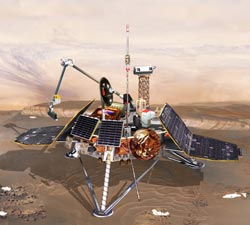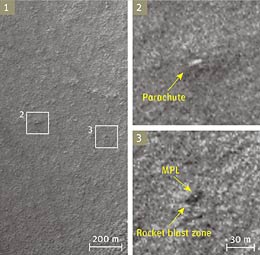
Mars Polar Lander disappeared without a trace on December 3, 1999. No one has seen any evidence of the ill-fated craft — until now.
Courtesy NASA/JPL.
In December 1999 NASA's Mars Polar Lander (MPL) was supposed to touch down near the red planet's south pole. But shortly after it entered the Martian atmosphere, the spacecraft disappeared without a trace. Only now, 5½ years later, do scientists think they may have finally located the lander's wreckage and confirmed what went wrong with the mission. The full report, by planetary scientist Michael C. Malin (Malin Space Science Systems), appears in the July 2005 issue of Sky & Telescope, now in press.

When Mars Polar Lander descended toward the red planet on December 3, 1999, it did so silently. It was scheduled to send a signal to Earth after touchdown, telling about its descent. The transmission never came. Investigators concluded that MPL’s landing rockets cut off prematurely and that the craft fell several dozen meters to its death. Until now, this scenario was purely speculation.
S&T diagram.
Malin used his company's Mars Orbiter Camera (MOC) aboard NASA's Mars Global Surveyor to search for the missing spacecraft in late 1999 and early 2000, but apparently came up empty. Shortly thereafter, a review board looking into the craft's disappearance reported what might have caused Mars Polar Lander's demise. The board suggested that MPL's landing rockets fired at the right time and altitude but cut off prematurely. They were suppose to continue firing until one of the craft's landing legs touched the surface. Apparently the onboard software mistook the jolt of landing-leg deployment for ground contact and shut down the engines, causing MPL to fall from a presumed height of 40 meters (130 feet).
Using information gained from observing the two Mars Exploration Rover landers last year, Malin reexamined the 1999 and 2000 images looking for similar features. This time he identified what looks to be a parachute located several hundred meters away from a disturbed bit of ground with a large mark in its center. The parachute-like feature closely matches the Mars Exploration Rover parachutes (which were made of the same materials), and Malin believes the disturbed ground matches what one would see if a rocket had blasted the surface from a height of tens of meters.

The search for Mars Polar Lander was hampered by inexperience: the team didn’t know what a parachute should look like or how the ground would be disturbed by the landing rockets. Lessons learned from observations of the Mars Exploration Rover landing sites helped team members identify what they think are the parachute (2), the rocket-blast zone, and ultimately the lander itself (3).
Courtesy NASA/JPL/MSSS.
"It seems that the MPL investigation board may have been correct," writes Malin in Sky & Telescope. "MPL’s descent proceeded more or less successfully through atmospheric entry and parachute jettison. It was only a few short moments before touchdown that disaster struck."
Later this year NASA will direct Mars Global Surveyor to reexamine the MPL crash site using a special technique to improve the camera's resolution to 0.5 meter per pixel. Malin hopes the new observations will provide the conclusive evidence needed to officially close the case of the missing Mars Polar Lander.
The July 2005 issue of Sky & Telescope is on sale at newsstands worldwide from May 31st to June 27th. Due to intense public interest in the Mars Polar Lander story, we are making Michael Malin's article available immediately via our S&T Magazine Archive:
Accredited editors and producers may request a free copy of the PDF from Marcy McCreary (855-638-5388 x143, [email protected]). S&T Magazine Archive subscribers may download the 1-megabyte PDF file for free after logging in at SkyandTelescope.com. Nonsubscribers (i.e., members of the general public) may purchase the PDF a la carte for $2.95.
To open the PDF you will need a copy of the free Adobe Reader, which is available for PCs, Macs, and Unix-based computers on Adobe's Web site.
 0
0
Comments
You must be logged in to post a comment.